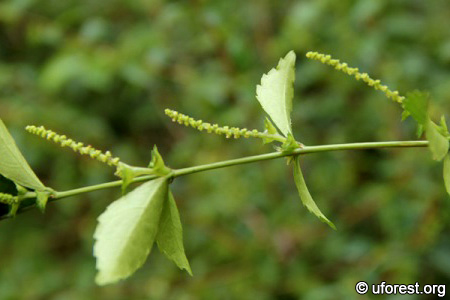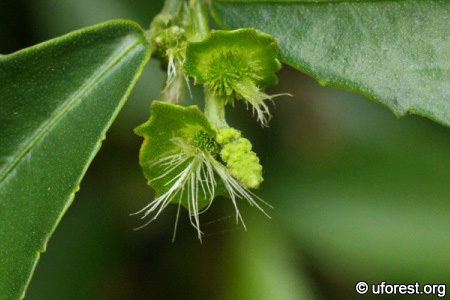| Etymology | Genus | Nettle-like; referring to the leaves that resembles Nettle plants |
|---|---|---|
| Species | Siam, old name for Thailand; where it was first described | |
| Family | Euphorbiaceae | |
| Synonyms | Acalypha evrardii Gagnep. | |
| Common Names | Siamese Acalypha, Tea Leaves | |
| Status | Exotic: Casual | |
| Form | Shrub | |
| Native Distribution | Thailand, Vietnam, Peninsular Malaysia, Sumatra, and Sulawesi | |
Diagnostics:
The Siamese Acalypha is a low shrub growing up to 2.5m (Sagun et al., 2010). The leaves are very distinctive, being diamond-shaped, having serrated margins (less pronounced near leaf base), lacking a petiole, and arranged about 45° from the branch.Interesting Facts:
There are two varieties known, and the one in Singapore is Acalypha siamensis var. siamensis (Sagun et al., 2010). The other variety, Acalypha siamensis var. denticulata is present in Thailand.
The flowers are arranaged in a spike, with the female flowers (subtended by a large bract) near the base and the male flowers (very small, and subtended by a small bract) towards the tip. The fruits are tri-lobed, spiny, and green. I have observed groups of House Sparrows peeling off the fruit skin and eating the seeds, which could be a possible medium of dispersal.
Spontaneous occurrences of Acalypha siamensis have been recorded in the various localities: along Kent Ridge Road, Mandai Track 7, the northern end of Punggol Road, Orange Grove Road, in Jurong Lake Park, Punggol residential estate, in the secondary forest off Commonwealth Avenue West, Kallang Riverside Park, Pearl's Hill City Park, and Bukit Batok Nature Park (Teo et al., 2011). These were probably established when it was cultivated more intensely in the 1960-1970s.

Leaves of the Siamese Acalypha.

A hedge of Acalypha siamensis

Bisexual spike inflorescence.

The female flower is subtended by a large bract.

The fruit is spiny with three joints.

A sparrow feeding on the fruit.
References
Sagun VG, GA Levin & PC van Welzen. (2010) Revision and phylogeny of Acalypha (Euphorbiaceae) in Malesia. Blumea, 55(1): 21-60.Teo S, KY Chong, BR Kurukulasuriya, YF Chung & HTW Tan. (2011) The status of an exotic shrub, Acalypha siamensis Oliv. ex Gage (Euphorbiaceae), in Singapore. Nature in Singapore, 4: 227-231.
Author: Siyang
Posted: 2013-01-12 / Modified: 2018-11-08